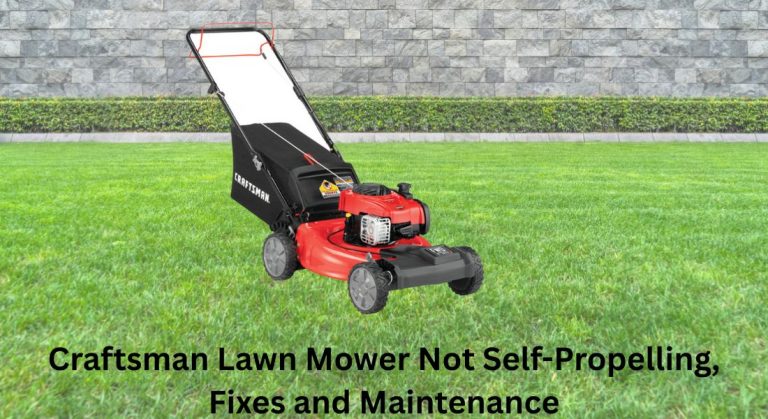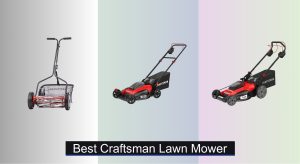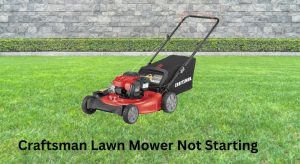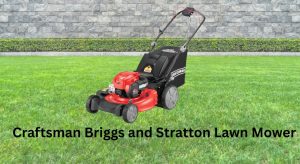When your Craftsman lawn mower’s self-propel feature stops working, mowing turns from a breeze into a workout. If your Craftsman lawn mower is not self propelling, a quick fix many owners find works is tightening or reattaching the drive belt and adjusting the drive cable tension. In many cases, the belt has slipped off or stretched, or the cable has loosened—both are fast adjustments you can do at home.
In this guide, you’ll learn every practical fix—from simple checks like wheel and cable inspection to deeper repairs like transmission service. We’ll cover common causes, step-by-step solutions, how to prevent future issues, and when it’s time to call a pro. By the end, you’ll have your mower pulling itself again and know how to keep it that way.
Common Causes of a Craftsman Lawn Mower Not Self-Propelling
- Loose or stretched drive cable: The handle-mounted drive cable can stretch over time, preventing the transmission from engaging fully.
- Worn or slipped drive belt: A glazed, cracked, or off-track belt can’t transfer power from the engine to the transmission.
- Worn drive wheels or wheel ratchets: The internal wheel gears/ratchets wear or get clogged with debris and slip under load.
- Damaged transmission or stripped drive pinion: Internal gears wear or break—often after long use or heavy load.
- Debris jam in drive system: Grass, twigs, and mud can pack into belt guards or wheel hubs and cause slipping.
- Improper cutting height or heavy load: Thick, wet grass or too-low deck height overloads the self-propel system.
- Engine speed too low: A low idle, clogged air filter, or carburetor issue causes weak drive power.
- Broken or weak drive cable spring/lever: The bail control or spring fails to return/hold tension.
- Misaligned or damaged drive pulley: The engine or transmission pulley can wobble or be bent, leading to belt slip.
How to Fix a Craftsman Lawn Mower Not Self-Propelling

Important: For all steps, remove the spark plug wire before working and tilt the mower with the air filter/carburetor side up to avoid fuel and oil leakage.
Method 1: Quick Checks and Cable Adjustment
Time: 10–20 minutes
Tools: Basic pliers, 3/8″ or 7/16″ wrench (varies by model), safety gloves
Diagnosing the Issue
- Squeeze the drive bail (self-propel lever) and watch the cable. It should pull firmly at the transmission end.
- If the cable housing or anchor is loose, or the lever has excessive free play, tension is likely the issue.
Fix Steps
- Reconnect the spark plug wire only to observe movement (do not start).
- Squeeze the drive lever; verify the transmission arm moves.
- Locate the cable adjuster near the handle or mid-cable barrel adjuster.
- Loosen the lock nut, turn the adjuster to increase tension until slack is removed.
- Tighten the lock nut. Ensure the lever is comfortable and the wheels don’t creep when the lever is released.
Tip: If there’s no adjuster or it maxes out, the cable may be stretched—replace it.
Testing
- Reconnect plug wire, start engine, engage self-propel on flat ground.
- If still weak or intermittent, proceed to belt inspection.
Method 2: Inspect and Replace/Tighten the Drive Belt
Time: 20–45 minutes
Tools: Socket set, screwdriver, replacement belt (refer to your model number), gloves
Diagnosing the Issue
- Symptoms: Self-propel works briefly, slips on hills, or only after warm-up. Belt appears shiny/glazed or cracked.
- Check your Craftsman model tag (usually under the seat on riding mowers or deck for walk-behind) and confirm the correct belt part number in the manual or parts diagram.
Fix Steps
- Disconnect spark plug wire. Tilt mower carburetor side up.
- Remove the front/bottom drive cover or belt guard screws to expose belt and pulleys.
- Inspect belt condition and alignment. Clean packed debris.
- If loose or off, re-seat on engine and transmission pulleys in correct routing.
- If worn, remove belt:
– Release belt tensioner if equipped.
– Slide old belt off pulleys. - Install new belt:
– Route per diagram; ensure ribs/sides sit properly.
– Verify the belt rides within pulley grooves and isn’t twisted. - Reinstall belt cover and secure screws.
Testing
- With engine off, push mower forward with lever engaged—front wheels should lock/drive.
- Start and test on flat, then light incline. If slipping continues, check wheels and ratchets.
Method 3: Service Drive Wheels and Ratchets
Time: 20–35 minutes
Tools: Socket/wrench set, rag, degreaser, replacement wheel gears/ratchets if worn
Diagnosing the Issue
- Front-wheel-drive models: Wheels spin freely even with lever engaged, or they drive intermittently.
- Clicking/grinding or one wheel drives and the other doesn’t.
Fix Steps
- Remove wheel caps (pry off) and wheel nuts. Pull wheels off.
- Inspect the plastic gear/teeth inside the wheel and the metal drive pinion on the axle.
- Clean debris and old grease. Look for rounded or worn teeth.
- Lightly lubricate with dry or light grease; avoid excessive grease that holds debris.
- Replace worn wheel gears or the pinion/axle gear as needed.
- Reinstall wheels, nuts, and caps snugly.
Testing
- Engage self-propel and push; wheels should engage strongly without skipping.
- If both wheels still slip, inspect the transmission pinion and cable again.
Method 4: Transmission and Pulley Alignment Check
Time: 30–60 minutes
Tools: Socket set, belt tool, flashlight, replacement transmission if needed
Diagnosing the Issue
- Belt and cable are good, wheels/gears are good, but there’s little to no drive.
- Visible wobble on transmission pulley or grinding from gearbox.
Fix Steps
- Remove belt cover. Spin the transmission pulley by hand—it should rotate smoothly and drive the axle.
- Check pulley set screw/clip—tighten if loose. Inspect keyway for damage.
- Inspect transmission case for leaks/cracks; listen for gritty movement.
- If pulley or shaft is bent, or transmission fails to turn the axle under hand pressure, replacement is likely required.
- Replace transmission:
– Note cable and belt routing.
– Unbolt transmission, detach drive cable and belt.
– Install new unit, reattach belt and cable, set cable tension.
Note: Transmission replacement is moderate difficulty; consult your model’s service manual or an illustrated parts diagram for exact steps.
Testing
- With new/secured transmission and correct cable tension, test on a flat area, then on a moderate incline.
Method 5: Engine Speed and Load Factors
Time: 10–15 minutes
Tools: None or basic tools for air filter/spark plug
Diagnosing the Issue
- Self-propel feels weak only under load or in tall grass.
- Engine sounds bogged or idles low.
Fix Steps
- Set throttle to full (if equipped) when using self-propel.
- Replace/clean air filter; replace spark plug if old.
- Mow at a higher deck height on first pass; make a second pass lower.
- Avoid wet or extremely thick grass passes; overlap narrower swaths.
Testing
- Engage self-propel on dry, moderate grass. If drive works well on light load but fails under normal load, revisit belt and transmission.
Prevention Tips and Maintenance Advice
- Clean under the deck and belt cover after each mow in heavy growth.
- Inspect the drive cable tension monthly during the season; adjust if lever free play exceeds 1/2 inch.
- Replace the drive belt every 1–3 seasons depending on usage; sooner if cracked or glazed.
- Keep wheel hubs and gears clean; lightly lubricate moving parts with dry lubricant to repel debris.
- Avoid mowing wet grass; it increases load and packs the drive system with clippings.
- Store the mower indoors; heat and humidity degrade belts and cables.
- Check wheel tread and inner gear wear at the start and mid-season.
Pro Tips
- Label routing: Take a phone photo of belt and cable routing before disassembly for quick reassembly.
- Use OEM or high-quality belts: Cheap belts stretch faster and slip, reducing drive power.
- Cable lube: A few drops of cable lubricant at the sheath ends reduce friction and extend life.
- Tension sweet spot: Too-tight cable causes constant engagement and premature wear; set it so wheels don’t creep at idle with lever released.
- Replace wheels in pairs: If one wheel’s gear is worn, the other is often close behind—replace both for balanced traction.
- Inspect height adjusters: Bent or loose adjusters change wheel alignment and reduce traction.
- Check for hidden debris: Packed grass in the transmission guard or behind the front cover is a common, overlooked cause of slipping.
Professional Help: When to Call a Technician
- Persistent slipping after new belt and cable adjustment.
- Visible transmission damage, leaking grease, or grinding noise.
- Bent pulley shaft or severe wobble at the transmission.
- Seized or stripped axle drive pinion.
- You’re unsure of belt routing or cable anchoring on your specific model.
What to look for in a service provider:
– Experience with Craftsman walk-behind drive systems.
– Access to OEM parts and model-specific diagrams.
– Written estimate and warranty on parts/labor.
Typical costs:
– Drive cable replacement: $40–$90 parts and labor.
– Drive belt replacement: $50–$120.
– Wheel gear/pinion service: $60–$130.
– Transmission replacement: $150–$300+ depending on model and labor rates.
Warranty considerations:
– If your mower is under warranty, contact Craftsman/Sears or the retailer before DIY repairs that involve drivetrain disassembly.
– Keep receipts and photos of issues for claims.
FAQ
Q: Why does my Craftsman self-propel work only sometimes?
A: Intermittent drive usually points to a stretched cable or a slipping belt. Heat can expand components and change tension, making it work cold but fail warm. Adjust or replace the cable and inspect the belt for glazing.
Q: How tight should the drive cable be?
A: Remove slack so the transmission arm starts moving as soon as you squeeze the lever, but ensure the wheels do not creep when the lever is released. Typically, 1/8–1/4 turn adjustments can make a big difference.
Q: How do I know if the belt is bad?
A: Look for cracks, shine (glaze), fraying, or a belt that rides low in the pulley. If you can push the belt more than about 1/2 inch off the pulley with light pressure, tension may be insufficient or the belt is stretched.
Q: My mower pulls on one side—what’s wrong?
A: Uneven wheel gear wear or a damaged axle pinion can cause one wheel to engage more than the other. Inspect both wheels’ internal gears and the axle pinions; replace worn parts in pairs when possible.
Q: Can low engine speed affect self-propel?
A: Yes. The transmission relies on engine power. A clogged air filter, old fuel, or carburetor issues can reduce RPM and torque, making the drive feel weak. Service the engine and use fresh fuel.
Q: Do I need special tools to replace the transmission?
A: Most models require only basic sockets, screwdrivers, and pliers. However, following a model-specific diagram is crucial. If the pulley is seized or the axle is corroded, penetrating oil and a puller may be needed.
Q: How often should I replace the drive belt?
A: With normal use, every 1–3 seasons. Heavy, wet mowing or sandy conditions wear belts faster. Inspect mid-season and replace at the first sign of glazing or cracking.
Alternative Solutions
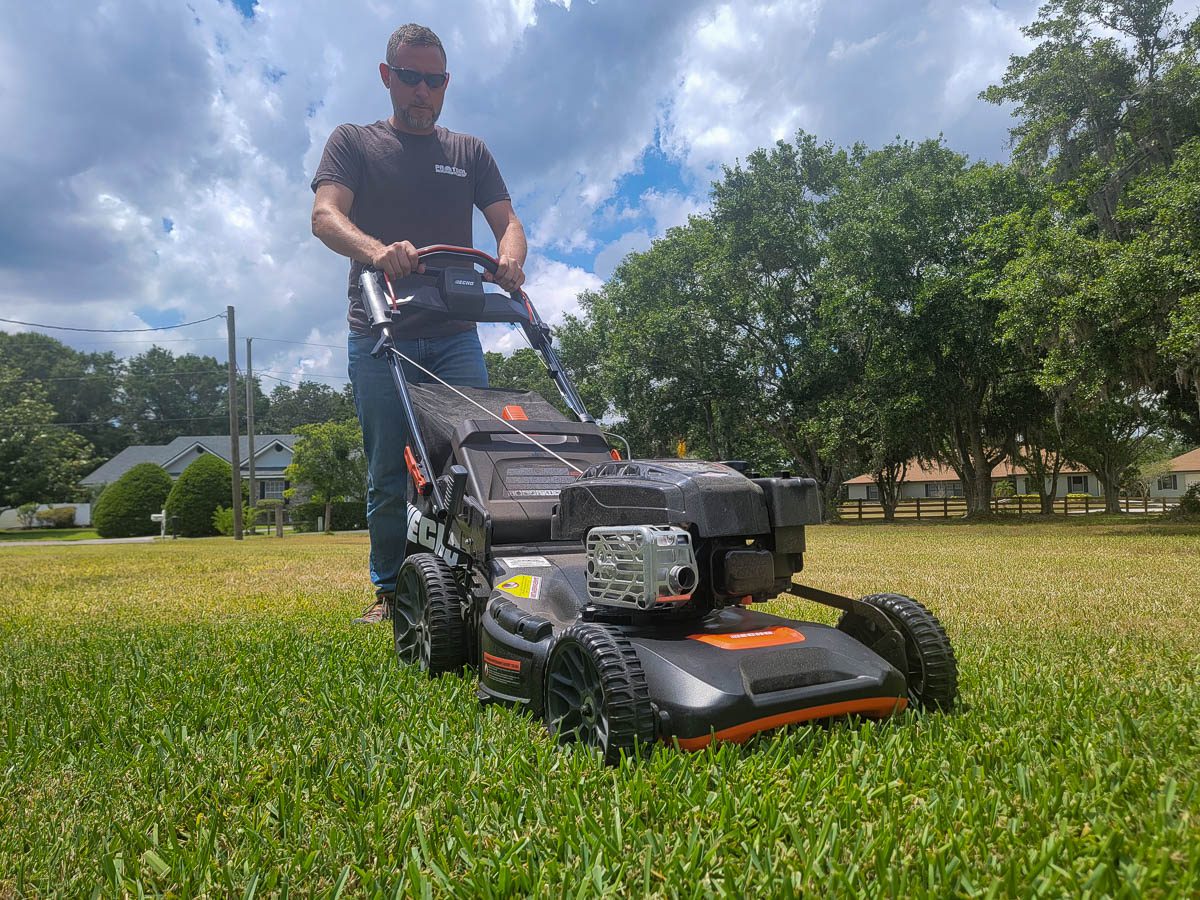
Sometimes repair costs approach the mower’s value, or your mowing conditions demand more power. Consider these alternatives:
| Solution | Pros | Cons | Best For |
|---|---|---|---|
| Replace with higher-torque self-propel model (rear-wheel drive) | Better traction on hills, stronger transmissions | Higher cost | Hilly yards, thick grass |
| Upgrade to all-terrain drive wheels | Improved grip, inexpensive | Doesn’t fix belt/transmission issues | Sloped/uneven terrain with otherwise healthy drive |
| Electric self-propel mower | Low maintenance, instant torque | Battery cost/charge time | Small to medium yards, light maintenance |
| Professional seasonal service plan | Prevents mid-season failures | Annual cost | Busy owners who want reliability |
Get Your Craftsman Mower Self-Propelling Again
By following this guide, you have multiple proven ways to fix a Craftsman lawn mower not self propelling:
– Adjust or replace the drive cable
– Inspect, re-seat, or replace the drive belt
– Clean or replace drive wheels and ratchets
– Check pulley alignment and transmission health
– Optimize engine speed and mowing load
Tackle the quick checks first—cable and belt issues solve most cases in under an hour. Keep debris out of the drive system and inspect parts each season to prevent future failures. You’ll be back to effortless mowing and longer equipment life.
Still stuck or have a specific Craftsman model? Share your model number and symptoms in the comments for tailored advice. Found this helpful? Bookmark this guide for your next tune-up. With these steps, you can solve your Craftsman lawn mower not self propelling today and keep it running strong all season.

